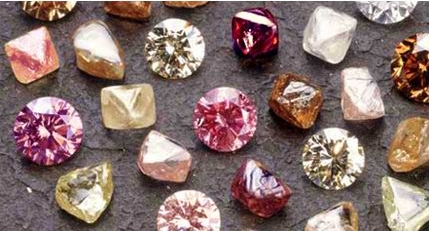You may be surprised to learn that there are natural diamonds that exist that are every color of the rainbow–the coloration being from nature, not man. They are rare, they are stunning and they are expensive. To own one would require a hefty bank account, but to own a natural diamond that has been colored, synthetically, (‘treatment produced’) is a very exciting option! Gemologists can manipulate less desirable stones by altering their colors—genuine diamonds with synthetic colors. Diamonds requiring a “make-over” can be affordably transformed into beautiful, vibrantly-colored gems.
How Coloration Is Achieved:
There are three main processes that are utilized to achieve the dynamic coloration of natural diamonds:
Diamond Irridation:
This process uses a stream of electrons to change what is called the ‘crystallographic structure’ of the diamond. The color produced is permanent and does not alter any property of the diamond, except the color, itself. Blue, yellow, green, orange and red are the colors that best suit this particular method, though an array of other colors is available.
Less desirable diamonds that, originally, had brownish color tone or black inclusions (flaws) can be impressively transformed; the results are stunning!
Plasma Deposition Coloring:
This state-of-the-art technique coats the natural diamond with a colored, diamond-like film. Normal wear and tear will not affect the permanent coloration; and the filmed colors produced, appear totally natural, even under a powerful microscope. The film is less than a millionth of an inch thick and has no affect on the diamond’s original weight. Pink, purple, violet, red and orange work best with this treatment.
High- Pressure / High- Temperature Process:
Interestingly, less desirable, naturally-occurring colors, such as brownish hues, can be eliminated and transformed into white or near-white gems. Conversely, colorless diamonds can take on a whole new ‘personality’ by transforming their lack of color into lovely greenish, yellow or yellow-orange hues.
The down-side of this process, however, is a ‘frosting’ effect that can materialize on the diamond’s surface which would require a re-polish. Additionally, minimal weight-loss can occur; and a diamond’s clarity could be, somewhat, compromised.
As long as there have been gemstones, there have been attempts to enhance their appearance. With the incredible advances in technology, efforts to transform diamonds and other gems, in one fashion or another, have become increasingly sophisticated, adding beauty and enchantment to an, otherwise, lifeless stone.
Whether you choose to buy a synthetically-colored, genuine diamond or transform a lifeless diamond you already have into one of the colors of the rainbow, the finished product will take your breath away!
Miss Carlson writes regularly and enjoys covering the topic of diamonds and king baby jewelry.


